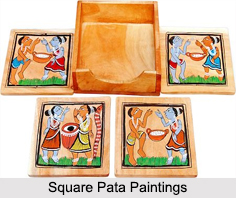 The square pata paintings also known as chaukash or square patas were once in trend in the Birbhum district of the state of West Bengal. The square pata paintings are a single painted frame which dealt with a particular deity or a mythical or social subject or an animal. The square pata paintings would not be accompanied by a song, its purpose being more of a quick commercial return.
The square pata paintings also known as chaukash or square patas were once in trend in the Birbhum district of the state of West Bengal. The square pata paintings are a single painted frame which dealt with a particular deity or a mythical or social subject or an animal. The square pata paintings would not be accompanied by a song, its purpose being more of a quick commercial return.
Themes of Square Pata Painting
The themes of the square pata paintings are always distinct drawn in vivid blue and green colours on a red background. It is said that folklorist and writer Gurusaday Dutt had collected several square patas paintings from Ayaspur and Ahmedpur villages of Birbhum District drawn by the two gifted artists named Mataru and Akshoy, respectively. The traditional style of Ahmedpur- Ayaspur is a classic feature of Bengal`s folk painting and is a unique and incomparable form of art.
Some of the themes of these square pata paintings were centred on Goddess Durga and the reign of Lord Rama. Some of the paintings on the Goddess used to portray Shiva and Durga with their two sons, Lord Ganesha and Lord Kartikeya, and two daughters, Goddess Saraswati and Goddess Lakshmi. While the others showed Durga in her war-like posture slaying Mahishasura. In these paintings, she is accompanied by her sons and daughters. The array of colours, the style of drawing and the trend of composition of these paintings seemed to reflect an expanded edition of Bengal`s traditional art of painting.
Types of Square Pata Paintings
The concept of square pata paintings has different interpretations and meanings for different tribes and people. Among the largest tribal community in India, the Santhals, there is a faction of patuas called Jadu Patuas whose folk paintings are based on rites and rituals, legends and myths, beliefs and prejudices on the life cycle of the Santhals. The tribal people of Santhal place a lot of faith on the Jadu Patuas, believing them to be the manipulators of life after death.
It is said that when a member of the tribal community dies, the Jadu Patuas paints a figure of the dead person, but leaves out the eyes. He then goes around the family of the deceased seeking cash on the plea that the dead person would not find his way into heaven if the eyes are not painted on the picture. This ritual is called the Chokkudaan and had a market naturally based on sentimental and superstitious ground.
In 19th century Kolkata, the urban incarnation of these square pata paintings was the Kalighat Pata, whose themes were not merely mythological but were also based on their own contemporary social life and often with satirical ends.
There are also several instances of square pata paintings being produced in woodwork and towards the end of the middle ages, there was a rise in wood, stone and clay craft. There are still remnants of these art forms in the likes of wooden chariots, idols of wood and stone, terracotta plates engraved on temple-walls and several other creations of artisans. These square pata paintings are very much in demand and are counted as a form of folk art of Bengal.



















